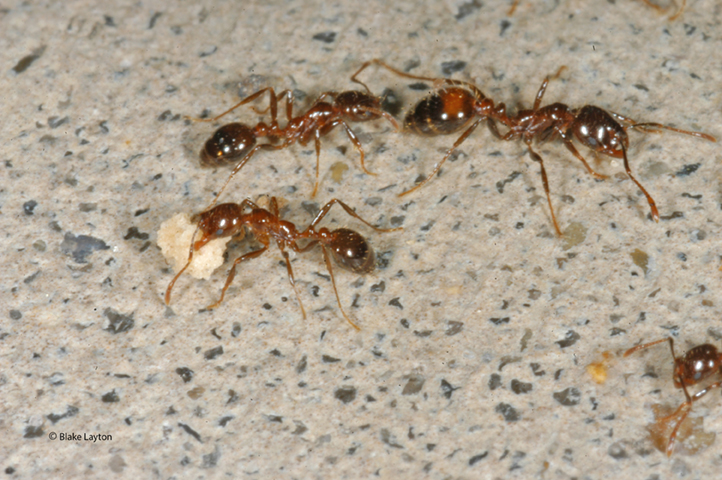Red Imported Fire Ants, Vol. 10, No. 04
Solenopsis invicta
Order: Hymenoptera
Family: Formicidae

Hot weather and fire ants are two of the more uncomfortable realities of life in the South. Fortunately, we have effective ways of dealing with both. Air conditioning works great for keeping the house cool, and granular fire ant baits work great for controlling fire ants. Timing and persistence are the keys to success for both problems. Miss a day running the AC in the summer, and it is going to get hot inside. Miss that spring application of fire ant bait and there are going to be a lot of fire ant mounds in the yard.
Even if there were no fire ants in the lawn last fall, you still need to treat for fire ants this year, because like last summer’s heat, they will return. How do they come back so quickly? It is not like many people think. They don’t just crawl over from the neighbor’s yard. Fire ants spread by swarming: hundreds of virgin queens emerge from a mound, fly into the air, mate with flying males, return to earth, and try to start a new colony. During these mating flights they can travel several miles from their home mound, depending on the wind. They are coming from neighboring areas, but those can be up to several miles away, and it is an aerial invasion.
The key to successful fire ant control is to be proactive. If you don’t want the house to get hot on an August afternoon, you must start running the AC before the house gets hot. If you don’t want to have big fire ant mounds in your yard, you must treat before you have big fire ant mounds in your yard. It takes several months for a newly founded fire ant colony to grow large enough to be visible above the grass. For every big mound you can see, there may be a dozen or more smaller colonies, too small to notice. This is when you want to control them, and regular application of granular fire ant bait, three to four times per year, is one of the best methods. Baits work on the mounds you can see, as well as on the ones you can’t.
Control: Knock fire ants out of your yard with a one-two punch. Apply a granular fire ant bait to the entire area using a small hand-held seeder to broadcast the bait according to label directions (Amdro, Advion and Extinguish Plus are examples of such baits). Wait a few days to give the ants time to collect the bait; then spot treat all visible mounds with a dry powder mound treatment, such as acephate (Ortho Fire Ant Killer and Surrender Fire Ant Killer are examples). Plan on making additional bait treatments in mid-summer and early fall, even if you don’t see any fire ant mounds in the yard and keep spot treating any mounds that do appear.
Use the holidays: Easter, Independence Day, and Labor Day to remind you when it is time for the next bait treatment. Put the right treatment in the right place. Dry powder mound treatments go on top of mounds; granular baits go over the entire yard. The ants will collect the bait granules and bring them back to the colony (see photo). Don’t waste bait; it takes less than you might think. Read that label. Even if you are mad enough at them to spend more money, it is better to make another application a few weeks later than to double up on the rate.
See Extension Publication 2429, Control Fire Ants in Your Yard for more information on fire ant biology and control.
Also see the MSU Extension Fire Ant Web Site for detailed information on fire ant biology and interesting fire ant facts, as well as information on controlling fire ants in special situations, such as pastures, orchards, or vegetable gardens. This site also includes information on organic fire ant control and how to control and prevent indoor fire ant invasions.
Blake Layton, Extension Entomology Specialist, Mississippi State University Extension Service.
The information given here is for educational purposes only. Always read and follow current label directions. Specific commercial products are mentioned as examples only and reference to specific products or trade names is made with the understanding that no discrimination is intended to other products that may also be suitable and appropriately labeled.
Bug’s Eye View is now on Facebook. Join the Bug's Eye View Facebook group here.

